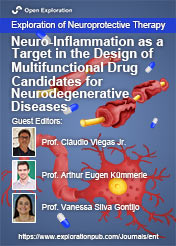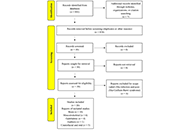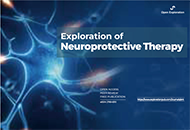
Neuro-Inflammation as a Target in the Design of Multifunctional Drug Candidates for Neurodegenerative Diseases
Guest Editors
Prof. Claudio Viegas Jr. E-Mail
Full Professor, PeQuiM- Laboratory of Research in Medicinal Chemistry, Federal University of Alfenas, Brazil
Research Keywords: drug design; neurodegenerative diseases; multi-target directed ligands; multifunctional drug candidates; hybrid molecules
Prof. Arthur Eugen Kümmerle E-Mail
Federal Rural University of Rio de Janeiro, Brazil
Research Keywords: pharmacy; drug discovery; organic chemistry; synthetic medicinal chemistry; medicinal and pharmaceutical chemistry; organic synthesis
Prof. Vanessa Silva Gontijo E-Mail
Federal University of Alfenas, Brazil
Research Keywords: antioxidant activity; oxidative stress biomarkers; free radicals; reactive oxygen species; phytochemicals; natural product chemistry
About the Special lssue
Neurodegenerative diseases (NDs) are a group of chronic, progressive, disabling, and incurable diseases, which represent one of the biggest challenges for the current research in the fields of medicinal chemistry and health sciences. NDs are a vast group of neuronal disorders that include Alzheimer’s disease (AD), Parkinson’s disease (PD, Huntington’s disease (HD), and amyotrophic lateral sclerosis (ALS) as the most common prevalent forms. The number of individuals with some kind of dementia is estimated from 46.8 million people worldwide in 2015 to a number close to 50 million people in 2017. Considering the current increase in the elderly population worldwide, especially in the most developed countries, this number is thought to almost double every 20 years, reaching 75 million in 2030 and 131.5 million in 2050. The etiology of such NDs is still not fully understood, but the elderly, associated with selective neuronal vulnerability, is considered the main risk factor. The biochemical and cellular basis of NDs have been intensively studied during the last 2 decades, and currently, there is a consensus that their hallmark is represented by complex multifactorial-based pathogenesis, affecting protein misfolding, immune system activation, mitochondrial dysfunction, oxidative stress, neuronal loss, and neuroinflammation. In the brain defense system, microglial cells act as macrophage-like cells, monitoring and regulating tissue homeostasis in the neuronal environment, and play a key role in neuroinflammatory conditions related to NDs. During their regulatory functions in brain homeostasis, these cells can undergo changes in their metabolism and morphology, leading to two types, named resting and activated microglia. Resting microglia may turn into other distinct phenotypes depending on the signals received and could originate an M1 state, that releases pro-inflammatory cytokines and other cytotoxic substances, which activate astrocytes and reinforce inflammation and neurodegeneration. Once activated, microglia produce proinflammatory and neurotoxic factors, including cytokines such as TNF-α, interleukin-1 beta (IL-1β), IL-6, and free radicals (e.g., NO, superoxide) as a response to immunological stimuli. Therefore, in the last decades, a number of results have demonstrated that inflammation around misfolding protein deposits leads to the destruction of neighboring neurons, being also responsible, at least in part, for an exacerbated oxidative condition, increasing the generation of radical species that, in turn, modify the intracellular environment and reinforce neuroinflammation. Thus, considering the lack of efficacy from the current available one-target selective drugs for the treatment of NDs, and that neuroinflammation is one of the key factors of installation and progression of NDs, the development of multi-target directed ligands, which includes anti-neuroinflammatory properties, could represent a great advance in the development of more effective and disease-modifying drug candidates for NDs.
Keywords: neuroinflammation; neurodegenerative diseases; multi-target directed ligands; neuroprotection; multifunctional drug candidates; drug design for neurodegenerative diseases
Published Articles

